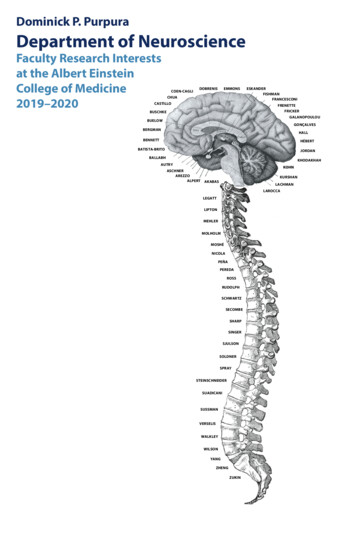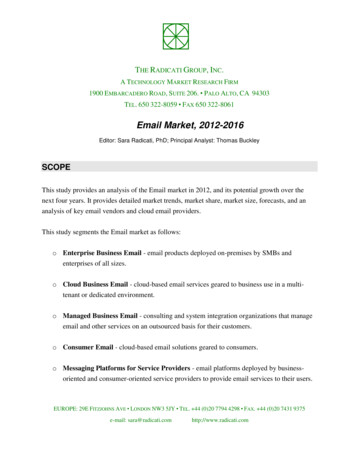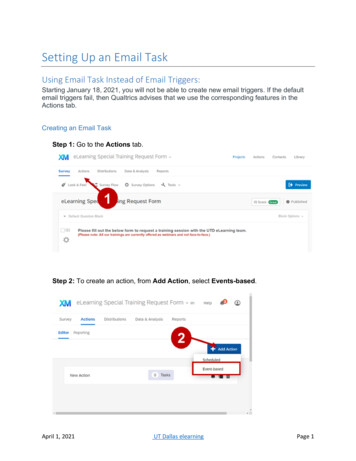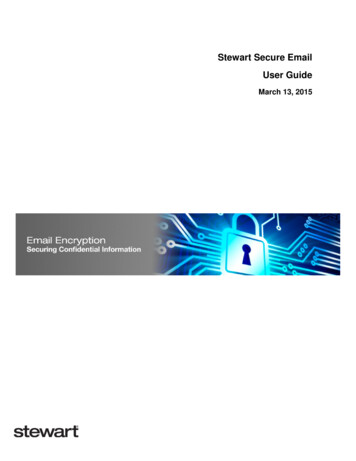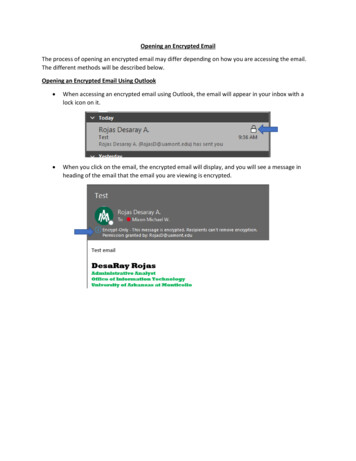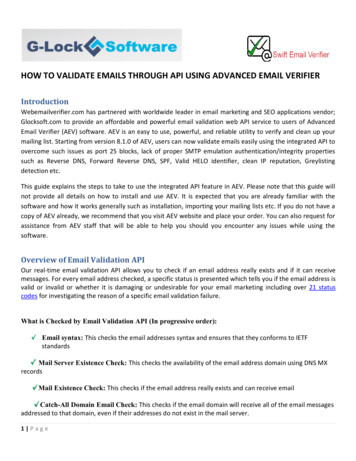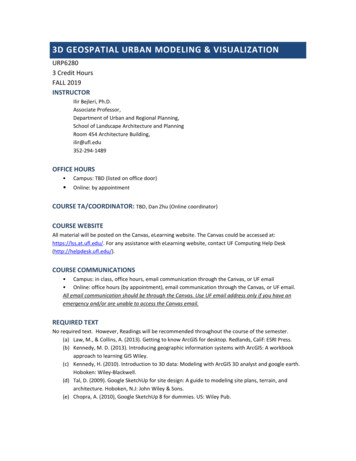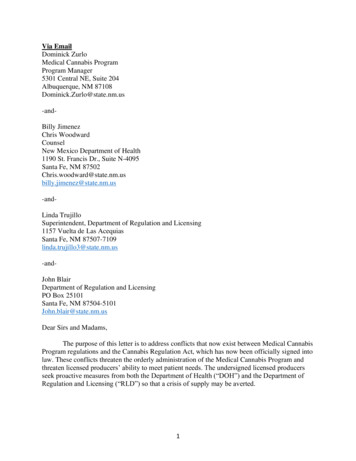
Transcription
Via EmailDominick ZurloMedical Cannabis ProgramProgram Manager5301 Central NE, Suite 204Albuquerque, NM 87108Dominick.Zurlo@state.nm.us-andBilly JimenezChris WoodwardCounselNew Mexico Department of Health1190 St. Francis Dr., Suite N-4095Santa Fe, NM .nm.us-andLinda TrujilloSuperintendent, Department of Regulation and Licensing1157 Vuelta de Las AcequiasSanta Fe, NM 87507-7109linda.trujillo3@state.nm.us-andJohn BlairDepartment of Regulation and LicensingPO Box 25101Santa Fe, NM 87504-5101John.blair@state.nm.usDear Sirs and Madams,The purpose of this letter is to address conflicts that now exist between Medical CannabisProgram regulations and the Cannabis Regulation Act, which has now been officially signed intolaw. These conflicts threaten the orderly administration of the Medical Cannabis Program andthreaten licensed producers’ ability to meet patient needs. The undersigned licensed producersseek proactive measures from both the Department of Health (“DOH”) and the Department ofRegulation and Licensing (“RLD”) so that a crisis of supply may be averted.1
The Cannabis Regulation Act Nullifies 7.34.3.9 NMACAs you may know, the Medical Cannabis Program currently enforces what is an effectivepurchase limitation on patients enrolled in the Program: patients can purchase only 230 grams, orapproximately eight ounces, of dried usable cannabis material in a 90-day period. At the time ofany sale, dispensary employees must enter a patient’s name and registry identification cardnumber into BioTrack and verify that the patient has not purchased more than 230 grams in a 90day period.Although the 230 grams is effectively a purchase limitation due to DOH’s mandate thatpurchases be entered into BioTrack, the relevant law actually contemplates a possessionlimitation. NMSA 1978, Section 26-2B-4(A) (2007, amended through 2019) provides thatqualified patients and caregivers “shall not be subject to arrest, prosecution or penalty in anymanner for the possession of or the medical use of cannabis if the quantity of cannabis does notexceed an adequate supply” (emphasis added). Section 26-2B-3(A) goes on to define “adequatesupply” as “an amount of cannabis, in any form approved by the department, possessed by aqualified patient or collectively possessed by a qualified patient and the qualified patient'sprimary caregiver that is determined by rule of the department to be no more than reasonablynecessary to ensure the uninterrupted availability of cannabis for a period of three months andthat is derived solely from an intrastate source” (emphasis added). Section 26-2B-7(A)(2) thendirects DOH to “define the amount of cannabis that is necessary to constitute an adequatesupply.”In keeping with the statutory emphasis on “possession,” rather than purchases, DOHpromulgated 7.34.3.9 NMAC, which provides that a “qualified patient and a qualified patient’sprimary caregiver may collectively possess within any three-month period a quantity of usablecannabis no greater than 230 total units (emphasis added). For purposes of department rules, thisquantity is deemed an adequate supply. (For ease of reference: 230 units is equivalent to 230grams, or approximately eight ounces, of dried usable cannabis plant material.).”Reading these sections together indicates that the “adequate supply” figure is apossession limitation: if the patient possesses more than the “adequate supply,” he or she may besubject to arrest, prosecution, or penalty. Although both the statute and the regulation are phrasedin terms of possession, DOH has always enforced a purchase limitation: because of the mandateto enter purchase amounts into BioTrack, licensed producers cannot sell more than 230 grams topatients in a 90-day period.For RLD’s edification, this purchase limitation is enforced collectively among the state’s30-plus producers. A patient cannot go to an Ultra Health dispensary, buy 230 grams, then go toa Sacred Garden dispensary, buy 230 grams, and then go to a Pecos Valley dispensary and buy230 grams. The patient can buy 230 grams in a 90-day period overall, because all of the state’sdispensaries and producers must use the same BioTrack database.The recently passed Cannabis Regulation Act nullifies the 230-gram possession/purchaselimitation, and as of the effective date of the Cannabis Regulation Act, enrolled patients will beable to purchase much greater quantities of cannabis than 230 grams in a 90-day period.2
First, Section 25(A)(1) of the Cannabis Regulation Act provides that the “followingconduct is lawful for a person who is twenty-one years of age or older and shall not constitutegrounds for detention, search or arrest of a person possessing, using, being under the influenceof, displaying, purchasing, obtaining or transporting not more cannabis than authorized by theCannabis Regulation Act or the medical cannabis program” (emphasis added).This is a very broad provision: it relates to a “person,” which plainly covers medicalcannabis patients. It specifically includes “purchasing” and “obtaining.” It also has no particulardate of efficacy, which means that the date of efficacy is June 29—the general effective date ofthe Cannabis Regulation Act. Thus, on June 29, New Mexico persons who are twenty-one yearsof age or older may lawfully purchase not more cannabis than authorized by the CannabisRegulation Act or the medical cannabis program.The amount of cannabis authorized for purchase by the Cannabis Regulation Act isconsiderably higher than that currently allowed by the Medical Cannabis Program. The amountis two ounces of cannabis, sixteen grams of cannabis extract, and 800 milligrams of ediblecannabis “at one time,” per Section 3(B)(4)(a) and Section 25(A)(2). Particularly, Section3(B)(4)(a) directs that rules provides that “a person who is twenty-one years old or older shallnot purchase more than two ounces of cannabis, sixteen grams of cannabis extract and eighthundred milligrams of edible cannabis at one time” (emphasis added).Furthermore, the two ounces/sixteen grams extract/800 milligrams edible cannabis is thepurchase limitation, and the lawful possession limitation is nonexistent. Section 26(A)(2) makeslawful, as of June 29, “possessing in excess of two ounces of cannabis, sixteen grams of cannabisextract and eight hundred milligrams of edible cannabis if the excess is stored in the person’sprivate residence and not visible from a public place.”Reading these provisions together, it is obvious that on June 29, it will be lawful for NewMexico persons who are twenty-one years of age or older to purchase not more than two ouncesof cannabis, sixteen grams of cannabis extract and 800 milligrams of edible cannabis at one time.It will also be lawful for New Mexico persons who are twenty-one years of age or older topossess more cannabis in their private residences.There is another provision in the Cannabis Regulation Act that also affects DOH’spractice of mandating that dispensaries track patient purchases in BioTrack. Section 6(M) statesin part, “As to activity under the medical cannabis program, the licensee shall continue to operateunder rules promulgated for the medical cannabis program until the division promulgates rulesfor medical cannabis activity, except that a qualified patient, a primary caregiver and a reciprocalparticipant shall not be prohibited from purchasing and obtaining cannabis productspursuant to the medical cannabis program” (emphasis added).This provision is even more generous: it plainly states that there shall be no prohibitionon qualified patients purchasing and obtaining cannabis products. This could very well mean thatpatients have no purchase limitations whatsoever and that on June 29, 2021, state regulatorscannot prohibit patients from purchasing as much cannabis as they wish.3
Now, DOH may claim that its 230-unit purchase limitation survives the CannabisRegulation Act. However, Section 70 of the Cannabis Regulation Act plainly states, “To theextent any administrative rules are inconsistent with the provisions of this act, such rules are nulland void.” 7.34.3.9 NMAC is very inconsistent with the provisions of the Cannabis RegulationAct, because it restricts medical cannabis patients—who by definition suffer from debilitatingmedical conditions—to a measly 230 grams in a 90 day period, while under the Act any personcan purchase two ounces, sixteen grams, and 800 milligrams.It would make no sense, and it would be highly prejudicial to the 112,000 sick NewMexicans enrolled in the medical cannabis program, to restrict medical access to 230 grams over90 days while the man on the street corner can safely purchase two ounces of cannabis from anillicit source.Second, NMSA 1978, Section 12-21-10 (1997), which is part of the Uniform Statute andRule Construction Act, provides that if there is an irreconcilable conflict between statutes, “thelater-enacted statute governs.” While Section 26-2B-4 exempts medical cannabis patients fromarrest, prosecution, or penalty for possession of no more than an “adequate supply,” Section25(A)(1) of the Cannabis Regulation Act exempts all persons twenty-one years of age or olderfrom arrest, prosecution, or penalty for “possessing, using, being under the influence of,displaying, purchasing, obtaining or transporting not more” than two ounces of cannabis, sixteengrams of extract, or 800 milligrams of edible cannabis. These two provisions are in directconflict, and the latter Cannabis Regulation Act prevails.In sum, on June 29, 2021, the 30-plus licensed medical cannabis producers should beprepared for patients to purchase two ounces of cannabis, sixteen grams of extract, and 800milligrams of edible cannabis at any one time. Furthermore, because the Legislature affirmed theCourt of Appeals’ interpretation that medical cannabis is exempt from gross receipts tax, theprice of cannabis will come down slightly, enabling patients to buy more than they havepreviously purchased.More Purchases Require Substantially More PlantsAfter this lengthy explanation of how the Cannabis Regulation Act affects purchaselimitations, DOH and RLD may wonder how this affects the undersigned licensed producers.It affects the licensed producers because on June 29, 2021, the higher purchaselimitations could result in a run-on medical cannabis. It has been the common experience of theundersigned producers that patients do not purchase as much cannabis as they truly wish to buy.They buy what they are legally allowed to buy, they buy what is available, and they buy whatthey can afford. The illicit market provides the rest. If patients can lawfully buy more fromlicensed producers, they will buy more, and if they can afford more because of the modest relieffrom sales tax, they will buy more.It would be truly unfortunate, and it would jeopardize the health of more than 112,000medical cannabis patients, if the medical cannabis supply ran out as patients took advantage of4
the more generous purchase limits. Producers do not wish to have to turn away patients whenthey have no more product to sell. And producers do not wish to have the patients then turn toillicit sources of cannabis: the street corner, Colorado, or Arizona.The likelihood of runs on cannabis, shortages, and turning away patients is much morelikely because of 7.34.4.8(A)(2) NMAC, which prohibits producers from growing more than1,750 cannabis plants larger than twelve inches. Producers can cultivate only a small number ofplants, and this means they will have a limited supply to serve the increased purchase limits ofpatients.Producers have experienced shortages for years, and those shortages have increased overthe past year. The patient population has ballooned to more than 112,000. The ongoing pandemichas increased the severity of patients’ medical conditions. Several producers have had theirproduction stymied by DOH’s delay in processing license amendments and inspections. Oneproducer is out of the market entirely due to a license revocation. The start of the outdoorgrowing season has been affected by severe weather. All of these factors mean that storesthroughout New Mexico are running out of product, even as producers continue to cooperate bymaking wholesale transactions. The current shortages are only a sneak peek of the extremeshortages that are likely to develop after June 29.Therefore, the undersigned producers request that DOH and RLD raise the plantlimitation until the full commercial market can be phased in. DOH’s rules already contemplatean increase in the coming months: 7.34.4.8(B) NMAC dictates that each licensed producer mayapply for an extra 1,000 plants after June 1, 2021. Releasing extra plants in April 2021 is notunreasonable when DOH already contemplated releasing extra plants in June 2021.While not sufficient, an additional 1,000 plants per producer would be the lowest amountthe DOH could possibly consider. In fact, a much greater increase is necessary. The newpurchase limit in the Cannabis Regulation Act is at least 22.2 times greater than the currentpurchase/possession limit allowed by DOH. If patients can purchase an amount of two ounces ofcannabis, sixteen grams of cannabis extract, and 800 milligrams of edible cannabis “at one time,”per Section 3(B)(4)(a) and Section 25(A)(2), then the purchase limit would potentially beunlimited, similar to other medications.If 1,750 plants-per-producer, with 34 producers (keep in mind, another licensee wasremoved from the program and we are down to 33 producers), was purported to be sufficient tomeet a purchase/possession limit of eight ounces over 90 days, then using an equivalent ratio, itwould take approximately 38,850 (1,750 x 22.2 38,850) plants per producer to meet a purchaselimit of two ounces per day. The number is much greater than 38,850 plants per producer ifpurchases are unlimited as defined under the new statute as “at one time.”A more conservative approach is to examine Colorado’s medical cannabis program.Colorado limits patients to two ounces per day, which is less generous than New Mexico’s twoounces at one time. Despite the difference, it is still reasonable to use Colorado’s history toobtain a figure of what patients will actually buy when given the option to buy higher amounts.5
The most recent per member per month (PMPM) data for Colorado shows patients purchased8.71 ounces PMPM, which is 3.22 times greater than the current purchase/possession limit.Again, using an equivalent ratio, it would take approximately 5,639 (1,750 x 3.22 5,639) plants per producer to meet purchases similar to Colorado’s PMPM. However, thiscalculation only accounts for flower purchases, which make up about 54% of medical cannabissales in Colorado. Extrapolating for New Mexico, each producer would need approximately10,443 (5,639/0.54 10,443) plants to account for the full product mix of two ounces ofcannabis, sixteen grams of extract, and 800 milligrams of edible cannabis.As you know, RLD will assume control of the medical cannabis program on June 29. SeeSection 5 of the Cannabis Regulation Act, “Except for administration of the medical cannabisregistry, the power, duty and authority of the department of health related to the medicalcannabis program shall be transferred to the division on the effective date of the CannabisRegulation Act.” It would not bode well for RLD’s public image as the regulator of cannabis ifthe medical cannabis program descended into chaos on June 29. New Mexicans, both citizensand legislators, are looking to RLD to smoothly manage the transition to a full commercialmarket, and if RLD allows the medical cannabis program to degrade further, public criticism willnot be withheld.For RLD’s edification, cannabis plants typically become harvestable approximately fourmonths after cultivation begins. Therefore, producers need significant lead time in order to havesufficient product on the shelf on June 29, 2021. The prudent regulator would thereforeimmediately raise the plant limitation on licensed medical producers, from 1,750 to at least5,500. Again, raising the limit was something DOH was already planning to do in June 2021.Alternatively, there exists reasonable evidence to support medical plants be increased from a lowof 10,000 plants per medical producer to possibly a high of nearly 39,000 plants or more permedical producer.Furthermore, the undersigned producers suggest that DOH and RLD immediately raisethe limit to count only mature plants, rather than on plants-larger-than-twelve-inches. As youknow, many parts of the Cannabis Regulation Act refer to “mature plants,” such as Section 9(B)and 9(C). The Act defines “immature” cannabis plant as one with no observable flowers or buds.Therefore, a mature plant would be one with observable flowers or buds. Referring to“immature” and “mature” plants, rather than 7.34.4.28 NMAC’s “seedlings,” would be anappropriate phase-in of the new Cannabis Regulation Act regime.Obviously, the undersigned producers have an interest in continuing to sell medicalcannabis, but the undersigned producers have a greater interest and concern in the wellbeing ofthe patients they serve. The licensed producers have supported 112,000 sick and vulnerable NewMexicans for many years now, and close relationships have formed between many produceremployees and the patients they serve. Producers are nothing without the patients they serve, andfor that reason, the producers continuously advocate for those patients. One cannot work in thisindustry for very long without developing a powerful sense of compassion and sympathy forthese patients, many of whom are merely one bad day away from disaster. The licensed6
producers wish to do everything to avert that bad day-one that could easily be catastrophic forsome patients.If DOH and RLD do not take proactive measures to secure the medical cannabis supply,it is likely that litigation will ensue as qualified patients enforce the purchase limitations in theCannabis Regulation Act.Public Statements Regarding SupplyGovernment representatives have repeatedly made public statements referencing the needfor sufficient supplies of cannabis. On March 18, 2021, RLD Superintendent Linda Trujillo toldthe Albuquerque Journal, "Our biggest fear is not there's going to be too much [ cannabis], butthat there would be too little and businesses would crash." On April 1, 2021, Rep. DeborahArmstrong told KOB that provisions in the legalization bill were there to "ensure that we have anadequate supply for the medical users." On April 10, 2021, Governor Michelle Lujan Grishamtold the Albuquerque Journal, "We have to start getting producers, growers, and farmers readyto go right now."With too little supply in the medical market, it will not only be businesses that could crash:patients could crash as the higher purchase limitations drive a run on cannabis.We would appreciate RLD and DOH's answer by Tuesday April 20 111, 2021.The Undersigned:Kylie Safa, Ultra HealthTrevor Reed, Budding Hope7
Fred Lucas, KureZeke Shortes, Sacrcc: The Honorable Governor Michelle Lujan Grisham8
Santa Fe, NM 87504-5101 John.blair@state.nm.us Dear Sirs and Madams, The purpose of this letter is to address conflicts that now exist between Medical Cannabis Program regulations and the Cannabis Regulation Act, which has now been officially signed into law. These conflicts threaten the orderly administration of the Medical Cannabis Program and
